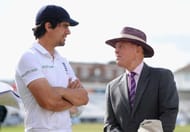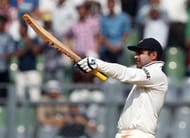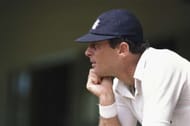E. H Carr argued that history is a “series of accepted judgements” based upon what the historian chooses to believe. It is the interpretation and selection of facts as well as the context attached to them that make up the body of knowledge. As such, the notion of objective historical facts selected without bias is flawed. Historical facts while necessarily accurate, are also selective. (Carr, 2001:5)
A cursory Google search reveals that Carr and Geoffrey Boycott never crossed paths. But had they done so, Boycott would have probably recognized a kindred spirit in him and slapped him on the back.
Boycott was a year away from making his first-class debut when Carr’s seminal ‘What Is History?’ was published, but the ideas discussed in it could easily be applied to his career and the oft-discussed but ill-defined ‘Geoffrey Boycott School of Batting’. Boycott’s style of batting divided opinion, and interpretations of it were polarized enough to ensure that there is a wealth of opinions to sift through while discussing it.
Before discussing his style of batting or what he achieved in the career, it is important to understand Boycott the man. William Wordsworth was decidedly not thinking of Boycott when he wrote that “The Child is the father of the Man”, but I put forth the opinion that Boycott the batsman was born out of the characteristics of Boycott the man.
What some saw as sacrifice and self-denial, others saw as selfishness
Boycott’s batting was defined by a bloody-minded focus, innate self-belief and a never-give-up, stiff-upper-lip frame of mind. The same qualities that allowed him to amass 8,114 Test match runs drove him in his successful quest to repel the menace of throat cancer long after his playing days had ended.
The same man who divided opinion in his role as a straight-talking commentator due to his refusal to compromise on his beliefs sat out three years in the prime of his career, yet managed to play 108 matches and finish his career as the leading run-scorer in Test match history at the time.
An unyielding, bloody-minded certainty in his beliefs drove both Boycott the man and Boycott the batsman. The harsh lessons learned from his frugal upbringing in the mining village of Fitzwilliam stood him in good stead for the challenges of Test cricket.
Both his personal and professional lives were marred by adversity; his spleen was removed at the age of 8 when he fell on a mangle, and at the age of 16 he believed his career was over before it had even begun when he was told he had to wear glasses while batting. A lesser man, or rather boy, may have quailed, but Boycott was made of sterner stuff. He took everything in his stride and soldiered on, his desire and intestinal fortitude overriding the limitations of his health.
Boycott scored runs, divided opinion and made occasional trips to the hospital due to illness brought on by his lack of a spleen. He was down a lot; sometimes he was knocked down by others and sometimes he fell down due to his refusal to compromise. But he always got back up.
His batting is revered and loathed in equal measure; what some saw as sacrifice and self-denial, others saw as selfishness. However, say what you will about the man, but he knew how to make a statement; he ended his self-imposed three-year exile by scoring his hundredth first-class hundred in an Ashes Test match, on his home ground of Headingley.
Like Carr’s history, recollection of Boycott the batsman is coloured by the interpretation of the person discussing it. His defenders point to the fact that only 20 of his 108 Tests ended in defeat, while his critics argue that he was selfish and was once dropped from the Test team for scoring too slowly. Yet, the score he made on that occasion was a marathon 246*, 82 more than the opposition managed in their first innings.
Only 20 of Boycott's 108 Tests ended in defeat, but only 35 ended in victory. Those are absolute truths; accurate historical facts that cannot be refuted. How they are interpreted colour the player portrait of Boycott the batsman.
The Geoffrey Boycott School of Batting
It is difficult to pinpoint what the defining characteristic of the ‘Geoffrey Boycott School of Batting’ is. I suppose that depends on what strikes you the most about his batting. Almost all reflections and recollections of his batting seem to suggest that it was about as entertaining as watching grass grow or paint dry. Yes, as an opener his first job was to take the shine off of the new ball.
For a manner of comparison though, Virender Sehwag - a man whose batting philosophy was the antithesis of Boycott - ended up with 472 more runs in four less games with an average 1.62 points higher. Does that mean that there was a better way for Boycott to have approached his job?
Perhaps there was a different way he could have gone about his business, but those statistics are somewhat mitigated by the fact that unlike Sehwag, Boycott batted in the era of uncovered pitches and played a vast majority of his games on treacherous, swinging wickets.
While that does not change the fact that Sehwag’s method of belting the new ball to get the shine off of it was cruder, and arguably just as effective, those of Sehwag’s ilk - David Warner, Michael Slater and Roy Fredericks - are considered anomalies in Test cricket because of how rare their kind is. If they are considered deviations, Boycott is assuredly the mean; the prototypical Test match opener.
However, dubbing the entire genre of staid Test match openers who believe that defence is the first form of attack as students of the ‘Geoffrey Boycott School of Batting’ is unfair for a number of reasons. Firstly, Boycott was far from the first opener to employ that philosophy, and nor was he the most successful; that accolade must surely go to Sunil Gavaskar. Secondly, to do so would be doing Boycott a disservice.
In recent vintage, Ed Cowan carved a respectable if unspectacular career for himself by batting time. However, while Cowan regularly brought up centuries in terms of balls faced, he rarely - if ever - pushed on to make a defining score. Boycott scored 22 centuries in his career, averaging out to a century every four games. He may have been boring, he may have soaked up time, but he translated that labour into match-defining runs.
Another example that springs to mind is Nick Compton. His last name may have been Compton, but his approach at the crease was nothing like the one applied by his grandfather. He believed in getting stuck in and like Boycott before him, decided early in his career that less is more in terms of strokes played.
Unlike Boycott though, the shackles imposed on his batting spread to the mental aspect of his game as well, and there developed an incongruence between his natural game and the shot selection he employed.
The beauty of Boycott lay in the fact that he was proud to be a tortoise; he had supreme confidence that his slow and steady approach would win the race. Compton’s first spell of Test Cricket ended because it was believed that England needed more proactive, dynamic players.
Desperate to make amends the second time around, he learned that just like it was impossible for the Ethiopian to “change his skin, or the leopard his spots” (Jeremiah 13:23), so it was impossible for a tortoise to suddenly become a hare.
Compton’s second spell in Test cricket ended when he tried to force the agenda and play too many shots - when he strayed away from his natural, defensive, solid game. Unlike Compton, Boycott never tried to be something he was not. It was the mental security resulting from his absolute conviction in his beliefs that allowed him to thrive by playing the way he did.
While bloody-minded defence and forcing the bowler to get you out rather than getting out yourself to a low-percentage shot are hallmarks of Boycott’s style of batting, part of the reason he was difficult to dismiss is because he did not feel the pressure of having to score quickly. He was always in control of the situation and he was the one dictating the pace of play; even if it was a slow pace.
It is not about getting bogged down, it is about getting the bowlers bogged down
In 2008, with a century for the taking at Perth, Rahul Dravid got himself out for 93. Having repelled Brett Lee, Mitchell Johnson, Shaun Tait and Stuart Clark on the fastest wicket in the world, he fell to Andrew Symonds of all people. Furthermore, it was a wild hoick in an attempt to force the pace that got him out.
In the period of play before his dismissal Dravid batted well within himself, patting the ball back here, leaving a ball there. All extravagant shots were cut out. There were no low-percentage shots before the slog, but the slog was brought on due to the mounting pressure caused by not scoring quickly. As Ian Chappell put it while doing commentary at the time, he was letting “part-timers dictate terms”.
Until he got out, Dravid was batting in a very Boycott-esque manner. However, while Boycott was dogged in defence, he never allowed himself to get bogged down to the point that he would play a stupid shot in order to try and release the pressure. In fact, one could argue that because he chose to play in that way of his volition, there was no pressure.
Where Dravid’s innings veered from the ‘Geoff Boycott School of Batting’ was in terms of dictating the pace of play. Boycott batted slowly because he chose to, not because the bowling dictated that he did so.
That Boycott’s stroke play or lack thereof was borne out of self-denial is proven by the fact that in the 1965 Gillette Cup Final he scored a scarcely believable 146 with 15 4s and 3 6s. Six years before the first one-day international and 10 years before the first World Cup, that was an astronomical display of stroke-making.
There's another piece of the puzzle getting filled; playing within yourself by choice.
The anti-Boycott - Virender Sehwag
It is almost poetic. The man named Boycott chose to boycott most of his strokes. Therefore, to qualify for the ‘Geoffrey Boycott School of Batting’, a batsman has to possess all the strokes but should choose not to play them. Building upon that premise, the next batsman I would like to put forward for consideration for entry is none other than the anti-Boycott himself - Virender Sehwag.
There would no doubt be some consternation at this choice. Granted, there is a vast incongruity between the two. Where Boycott went right, Sehwag galloped left. One believed first and foremost in scoring enough runs to ensure that his team never lost the game, the other had the ability to change the course of an entire match in a frantic session. One man was meticulous to the point of obsession, the other was laid back and believed in the simple batting mantra of “see ball, hit ball”.
Boycott relied on a textbook batting technique, Sehwag relied on incredible hand-eye coordination. It would appear that apart from forthrightness, the two have absolutely nothing in common. Yet, the fact remains that Sehwag, the man who once took a dig at Boycott by saying “Boycott can say what he wants.
He once batted the whole day and hit just one four”, once played an innings that went against every fibre of his batting philosophy. It was an innings that saw him bat an entire session without hitting a single boundary.
This is the same man who single-handedly derailed England’s hopes of defending a 4th innings target of 387 in one manic session. The same man who once bludgeoned 284 in a day. The same man who hammered the mighty Australians all around the MCG for 195 in one day.
Granted, there were extenuating circumstances to this torturous Sehwag innings I'm talking about; India were trying to draw the final Test match of the acrimonious 2007-08 tour. But having returned to the team the previous Test after Indian cricket had seemingly passed him by, Sehwag exhibited great self-restraint to bat through most of the last day at Adelaide to score an ultimately match-saving 151.
Technique be damned, as far as self-denial and mental strength went, this innings was straight out of the ‘Geoffrey Boycott School of Batting’.
For a man who loved to dominate as much as Sehwag, it was doubly impressive. It was the cricketing equivalent of taking a hard-core non-vegetarian to a buffet with every type of meat imaginable, and asking him to eat salad. It was Michael Schumacher and Sebastian Vettel being asked to drive in Delhi traffic. It was absolutely the last thing you would expect from Sehwag; that he did so and still managed a strike rate of almost 64 in the innings reinforces how great his self-denial was for that one session.
Another innings by a great Indian player on a tour of Australia characterized by great mental strength and self-denial comes to mind almost immediately here. Sehwag batted an entire session without hitting a boundary, but this man scored an unbeaten double century without playing a single cover drive. The man in question was Sachin Tendulkar, and the setting was the fourth Test match at Sydney in 2004.
Having been dismissed cheaply in previous games that series by nicking behind the wicket, he decided to shelve the cover drive for the time being. And just like that, he crafted an innings studded with every other shot in the book, and made the small matter of 241* - batting close to 10 hours.
Players have decided to shelve strokes in the past, but that is usually restricted to not playing extravagant shots and is specific to a particular context in the game. For example, an opener on a green track may decide not to play anything that isn’t on his stumps. A batsman on a dustbowl may decide not to hit against the spin early on in his innings. But to shelve the cover drive for almost 10 hours, even after crossing 150, is something else entirely though.
It could only be borne out of almost monk-like patience, incredible mental strength, razor sharp focus and an indelible belief in one’s ability to overcome adversity. From a purely mental perspective, this was right out of the ‘Geoffrey Boycott School of Batting’.
Batsmen must be driven, ambitious and greedy, but they must not be so to the detriment of the team

As always, there are two sides to every coin. What some perceive as self-denial channeled through great mental discipline, others perceive as pure selfishness. Boycott's detractors argue that he did not play the way he did because that was important to the success of the team, he played the way he did because his own success was more important than that of the team.
Boycott, they would have you believe, was the sort of chap who would argue that while there was no “I” in “team”, there was certainly an “I” in “cricket”.
The marathon innings, the self-discipline, the game plan that was focused on first ensuring that the team could not lose; might they all be viewed through the lenses of selfishness? After all, this is the man who was dropped after scoring 246*, for batting too slowly.
Perhaps an addendum is required here: he scored too slowly and contrary to the game-plan of the team. Test cricket has been built on graft and patience, and there is a difference between scoring slowly and scoring selfishly. It is the latter that has been levied against Boycott as an accusation.
It is important to qualify what constitutes as being selfish though. Cricket, though ostensibly a team game, comes down to a series of one-on-one battles between batsman and bowler. Batting or bowling for individual glory is not selfish in of itself. Batsmen must be driven, ambitious and greedy, but they must not be so to the detriment of the team.
The first name that springs to mind when thinking about giants of the game who have been accused of being selfish is Jacques Kallis. Was the great South African all-rounder a selfish player? Before we get into that, a comparison is in order. Stylistically at least, the player most closely associated with Kallis is Dravid.
Selfish is the last word you would use to describe Dravid. He reinvented himself as an ODI finisher, kept wickets so India could play an extra batsman in the ODI team, and was shunted up to open in Test matches repeatedly, even though he had voiced his preference for fulfilling the most thankless of all tasks in Indian cricket - coming in after a flimsy opening pair and before one Sachin Ramesh Tendulkar.
Both Dravid and Kallis built legendary careers through graft, patience and technically impeccable games.
There is little to separate them numbers-wise; Dravid scored 13,288 Test runs at an average of 52.31 and a strike rate of 42.51. Kallis scored 13,289 Test runs at an average of 55.37 and a strike rate of 45.97. In the one-day arena, Dravid scored 10,899 runs at an average of 39.16 and strike rate of 71.24, while Kallis scored 11,579 runs at an average of 44.36 and a strike rate of 72.89.
In fact, even after discounting the small matter of 292 Test and 273 one-day wickets, Kallis has a superior average and strike rate in both formats of the game. Therefore, at face value at least, to even consider calling him selfish seems absurd, disrespectful and sacrilegious.
Dravid was never accused of batting for his average. He carved a very successful career for himself despite the limitations of his game, through sheer hard work and a desire to do whatever was best for the team. Kallis, it could be argued, had a very successful career despite himself.
By no means am I questioning the hard work he put in; in fact, Matt Prior tells a story of Kallis “pounding away on the treadmill in the gym for half an hour as if he had done nothing all day", after having played a match-winning innings and taken wickets in a South African ODI victory over England. Even so, there is a sense that Kallis could have been so much more had he given full freedom to his considerable array of strokes.
Is that enough to classify him as selfish? Like Boycott before him, was he a supremely talented, extremely hard-working player who could have been so much more had he chosen to be? Were any of his innings detrimental to the team’s chances of victory?
Apart from an innings against Australia in the 2007 World Cup, where he scored 48 off 63 balls in an unsuccessful chase of 377, you would be hard pressed to find evidence of selfish batting from Kallis. Even in that particular instance, one could make the argument that he was playing the anchor role while more explosive players played around him.
Perhaps another word can be used to describe Kallis - perfectionist. It was not quite a fear of failure, it was merely a cold-blooded, pragmatic way of approaching the game that made him play the way he did. Not for him were the highs and lows of a more exhilarating style of play; he would rather be consistently boring. Perhaps consistent and boring is more apt. Did that make him selfish? If you believe in black and white answers, yes.
Theoretically, if Dravid and Kallis had similar styles of play and similar numbers, and Dravid is considered the consummate team man because he did everything he could for the team, does it not make Kallis selfish if he did not do the very same thing? But cricket is not black and white. It is true that with his incredible gifts, Kallis could have been so much more; the stroke-play of latter year ODI Kallis is proof of that.
Had he not designed his game to ensure that first and foremost he did not fail, an approach used by Boycott as well, you cannot help but think that such a supremely talented and hard-working cricketer could have ended up an even better player than he was.
Kallis did not go the extra mile. But was his pragmatic, risk-averse approach selfish? Or was it merely a boring, self-centered but successful approach to batting? And might we use the same paradigm to understand Boycott’s game?
How much of a role does match situation play in determining whether a player is being selfish?

I suppose it is the match situation that determines whether a player is being selfish. By all accounts, Boycott’s 246* was selfish - not because he scored slowly, but because the opponents, pitch and match situation dictated that he score quicker.
Alastair Cook’s marathon double centuries in Brisbane and Abu Dhabi were masterclasses in attrition. Yet, they are rightly held up as great innings by a great player. The difference between Cook’s epics and Boycott’s novel that should have been a novella are the different match situations. Put quite simply, the match situations Cook found himself in demanded innings of that nature, but the one Boycott found himself in did not.
If selfishness is definitively a trademark of the ‘Geoffrey Boycott School of Batting’, do all selfish innings qualify? At first glance, that question should be a non-starter. However, adding the “match situation” and “detrimental effect to the team’s chances of winning” qualifiers somewhat muddies the waters.
How do you reconcile the notion of selfishness in playing slowly where a match situation does not call for it, with an innings wherein the man doing all the scoring is selfish and the one slowing things to a crawl is selfless?
The innings I am referring to is Dinesh Chandimal’s unbeaten century in an ODI at Lord’s in 2011 that helped Sri Lanka successfully chase England’s 246. While they won with 10 balls to spare, his partner Angelo Matthews batted 21 deliveries for just one run in order to ensure that there were enough runs to chase for Chandimal to complete his century. It is easy to dismiss this as a case of no harm, no foul; after all, Sri Lanka won the match.
However, as they learned first-hand during Lasith Malinga’s stunning attempt at a jail-break in their 2007 World Cup clash against the South Africans, cricket has a habit of snatching defeat from the jaws of victory. You cannot afford to give the opposition even a sniff of a chance; as the old adage goes, when you have them down, you keep them down.
Matthews playing out a maiden on purpose in the 48th over of a run-chase can be viewed with confusion at best and suspicion at worst. Of course, it was all rather innocent, touching even; the 21-year-old prodigy was playing his first game at Lord’s and had batted his team to the brink of victory.
Of course he deserved a century. But at the possible cost of a win? Cricket has no room for sentiment; Dravid famously declared the Indian innings with Tendulkar unbeaten on 194 in a Test match against Pakistan.
But the real question is, who was selfish? Was it Chandimal for allowing Matthews to carry out his plan? After all, it was for his benefit. Was he culpable, even if he was not the one scoring slowly? Was Matthews’ innings detrimental to his team’s chances of victory, or can it be viewed as an innings played for the greater good of the team as it raised the confidence of a young batting star?
In fact, in the specific context of this game, one could argue that Chandimal, the partner scoring, was selfish and Matthews, the partner refusing to score, was selfless.
The fact that Sunil Gavaskar’s 36* off 174 in an ODI against England in 1975 is rightly called selfish while Matthews’ unbeaten 1 off 21 is considered selfless is proof that not all slow innings are selfish, even if they slow down run chases. Are they irresponsible? Undoubtedly. Are they foolishly sentimental? Indubitably. But selfish? No.
It is pertinent to mention here that despite all the confusion and diverging opinions surrounding Boycott’s unpopular moments - the aforementioned 246*, the time Ian Botham allegedly ran him out for scoring too slowly - his critics and supporters can agree on one thing; Boycott would have never played slowly in order to let a teammate complete a significant score.
So there you have it. The ‘Geoffrey Boycott School of Batting’ is as infuriating to pin down and understand as the man himself. As the late, great ‘Rowdy’ Roddy Piper famously said, “Just when they think they got the answers, I change the questions.”
Is it technical expertise and a risk-averse game that define it? Or is it built upon bloody-minded determination and mental strength? Does it refer to his style of play, his position as the prototypical Test match opener, or is it a function of his mental approach to the game? Can we dub all staid opening batsmen as Boycott clones? Are all players who score slowly when the team situation demands from the Boycott production line of batsmen?
I cannot say with certainty. Perhaps the easiest answer is the most widely accepted one: selfishness.
Boycott the batsman was a product of Boycott the man
I suppose how you define the ‘Geoffrey Boycott School of Batting’ depends upon how you perceive Boycott the batsman. As Carr noted, historical facts are necessarily “selective”. If Boycott’s career, like all before and all after him, is a “series of accepted judgments”, the judgment you choose to form or accept will be borne out of your perception of his game.
Personally, I believe that the ‘Geoffrey Boycott School of Batting’ refers to supreme mental strength and stiff-upper-lip-esque determination. My decision is based upon a number of factors.
Firstly, having never played the game at any sort of professional level, it is not for me to cast aspersions on the careers of great players, who have built the game, by speculating that they were selfish. Furthermore, I never saw Boycott play live and all my information on him comes from historical sources that are necessarily biased.
Max Weber’s notion of Verstehen plays a vital role in understanding this. What facts are chosen, how they are interpreted and the theories arising from these interpretations depend largely upon the norms and values that have been institutionalized within the chronicler.
For example, if an article on Boycott has been written by a Yorkshireman, he would necessarily be biased towards Boycott. As understanding comes “from within”, different chroniclers will select different facts and may also interpret the same fact differently.
It will not have gone unnoticed that three of the batsmen discussed in this piece are Indian; as I am Indian, India is the team I have followed the most closely. Therefore, it is only natural that I should select Indian batsmen while drawing comparisons.
Similarly, chroniclers of the past chose the facts that best suited their point of view. This in turn is largely based upon their social identity created by the institutionalized norms resulting from their internal environment. For example, a cricket fan who enjoys stroke-play would not consider Boycott his favourite player. That bias would seep into his account of his batting.
Essentially, we believe what we choose to believe. (Alder, 1997:326)
Secondly, as discussed, Boycott was not the first opening batsman to use the values of patience and a solid technique to great effect, and nor was he the most successful. I am willing to call the modern attacking opener a student of the ‘Virender Sehwag School of Batting’, because Sehwag truly revolutionized the art of opening and the role of the opening batsman. Boycott merely fulfilled the role handed to him to its fullest; he was a great teacher of that school of batting, but he did not found it.
Thirdly, there is something to be said for mental fortitude and discipline, the ability to overcome strife through sheer will-power. His technique may have been water-tight, but were it not for his mental strength - both in terms of focus and the belief that his method was the best method - it would have all been for nothing.
Boycott’s game needed the self-belief and focus his mental strength afforded him; that was the reason he was dogged and not a dodderer. He was able to thrive because he was confident in his own methods and secure in his own skin. Boycott’s entire career should have been set to the tune of “We Shall Overcome”, except that Boycott was not big on the concept of “we”.
Anchor Lastly, I believe that Boycott the batsman was a product of Boycott the man, and it is his mental strength and discipline that is his most recognizable and valuable trait. That it should be the defining feature of his batting is no surprise; it is the very essence of his being.
But then again, that is merely what this chronicler chooses to believe.
Brand-new app in a brand-new avatar! Download CricRocket for fast cricket scores, rocket flicks, super notifications and much more! 🚀☄️



